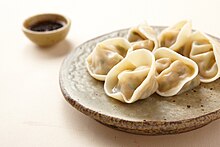Mandu (dumpling)

Jjin-mandu, steamed dumplings
|
|
| Alternative names | Dumplings |
|---|---|
| Type | Dumpling |
| Place of origin | Korea |
| |
|
| Korean name | |
| Hangul | 만두 |
|---|---|
| Hanja | 饅頭 |
| Revised Romanization | mandu |
| McCune–Reischauer | mandu |
| IPA | [man.du] |
Mandu (만두; 饅頭) are dumplings in Korean cuisine. They are similar to pelmeni and pierogi in some Slavic cultures. The name is cognate with the names of similar types of meat-filled dumplings along the Silk Road in Central Asia, such as Turkish manti, and Kazakh manty. Chinese mantou is also considered a cognate, which used to mean meat-filled dumplings, but now refers to steamed buns without any filling.
In Korean cuisine, mandu generally denotes a type of filled dumpling similar to the Mongolian buuz and Turkish mantı, and some variations are similar to the Chinese jiaozi and the Japanese gyoza. If the dumplings are grilled or fried, they are called gun-mandu (군만두); when steamed, jjin-mandu (찐만두); and when boiled, mul-mandu (물만두).
Mandu are usually served with kimchi, and a dipping sauce made of soy sauce, vinegar and chilli. They are often filled with minced meat, tofu, green onions, garlic and ginger.
Mandu are believed to have been first brought to Korea by Mongolians in the 14th century during the Goryeo Dynasty. The state religion of Goryeo was Buddhism, which discouraged consumption of meat. Mongolian incursion into Goryeo relaxed the religious prohibition against consuming meat, and mandu was among the newly imported dishes that included meat.
Another possibility is mandu came to Korea at a much earlier period from the Middle East through the Silk Road. Historians point out many cuisines based on wheat, such as dumplings and noodles originated from Mesopotamia and gradually spread from there. It also spread east along the Silk Road, leaving many versions of mandu throughout Central and East Asia.
...
Wikipedia
